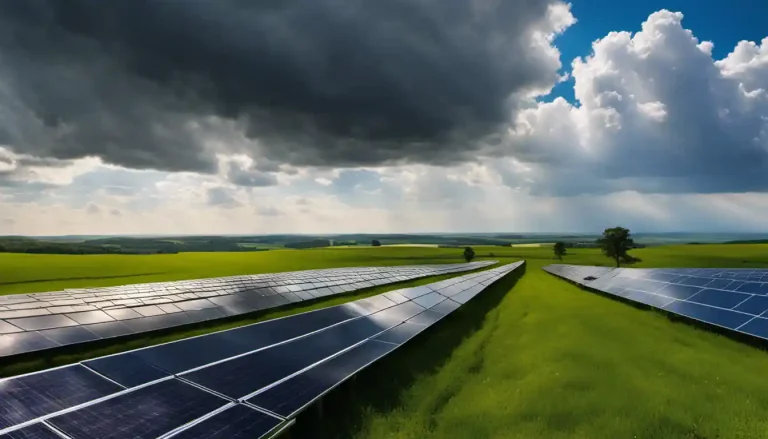Introduction to Solar Panels and Hail Damage
Yes, solar panels can be damaged by hail, but it’s not an everyday occurrence. Most modern solar panels are designed to withstand hail of up to about 1 inch in diameter, falling at a speed of up to about 50 miles per hour.
Defining Hail
But what exactly is hail? Picture this: you’re savoring a warm cup of tea and suddenly small balls of ice start dropping from the sky, hitting everything on their path. That’s right, hail is a type of solid precipitation that takes shape when there are strong upward currents of air in a thunderstorm.
Why is Hail a Problem for Solar Panels?
Hail can be problematic for solar panels because it can lead to physical damage, impacting the overall effectiveness of the panels. Now imagine a hailstone the size of a golf ball hitting your solar panels at highway speed. Sounds terrifying, doesn’t it?
Potential Damages from Hail to Solar Panels
Physical Damage to Solar Panels

Contrary to popular belief, general light hail does not pose an instant threat. That being said, hailstones larger than an inch in diameter could potentially cause damage. Scratches, cracks, or damaged cells can occur because of hail, which can affect the performance of the panel.
Impact of Hail on Solar Panel Performance
A bruised solar cell could result in a decrease in your solar panels’ energy output. However, this doesn’t necessarily mean the entire system would collapse. If one cell on a solar panel is damaged, for instance, only that portion of the array will be affected. The system’s overall performance would decrease slightly, but it’ll still keep on trucking.
Solar Panel Hail Resistance and Hail Ratings
Meaning of UL 61730 and IEC 61730 Solar Panel Ratings
You’ve probably heard of the terms UL 61730 and IEC 61730 in relation to solar panel hail ratings. They are both systematic methods of determining how well a solar panel can handle hailstorms. Basically, solar panels undergo rigorous testing for durability, where they’re bombarded with simulated hail at high velocities under these standards.
Solar Panel Hail Rating and its Importance
A high hail rating is a testament to the panel’s durability. When solar panels undergo testing, the hail rating can show how large or fast a hailstone the panel can withstand before suffering damage.
Warranty and Insurance Information

Warranty Limitations on Solar Panels Damaged by Hail
While most solar panel manufacturers offer a 25-year power performance warranty and a 10-year product guarantee, hail damage may be considered an “act of God”, leaving you in a pickle. However, some manufacturers have warranties that cover hail damage to an extent, depending on the solar panel hail rating.
Additional Insurance Costs
Fortunately, many homeowner insurance policies also cover solar panel damage, including from hail, which could be a huge relief in case Mother Nature strikes with a surprising hailstorm.
Prevention and Protective Measures against Hail Damage
Selection of High-Quality and Hail-Resistant Solar Panels
When considering solar installation, the quality of the panels should be a key factor. Choosing high-quality, hail-resistant solar panels will significantly minimize the potential for hail damage.
Use of a Temporary Protective Cover

Think of a car cover, but for your solar panels. Physical barriers could offer an added layer of protection against the wrath of hailstorms.
Inspection of Solar Panels after a Hail Storm
This is crucial. Regularly checking your panels after severe weather events ensures that any potential damage is detected early and rectified.
Solar Panels in Hail-Prone Areas
Should You Install Solar Panels in Areas Prone to Hail Storms?
You certainly can! While hailstorms are indeed a risk, they should not discourage you from installing solar panels. As we previously discussed in our article on “/how-does-weather-affect-solar-panels”, panels are designed to withstand a variety of weather conditions. The key is to make suitable choices like selecting panels with a good hail rating, ensuring they are properly installed, and having an effective insurance policy.
Weighing the Pros and Cons of Solar Panels in Hail-Prone Areas
Like any decision, it’s all about weighing the benefits against the risks. Solar panels provide renewable energy, reducing your reliance on traditional electricity supply – a wonderful pro. The risk of hail damage exists, but with the right protection, it can be mitigated.
In conclusion, while hail can damage solar panels, the risk is relatively small and manageable. For those considering solar panel installation, hailstorms should be a consideration, but not necessarily a dealbreaker.



